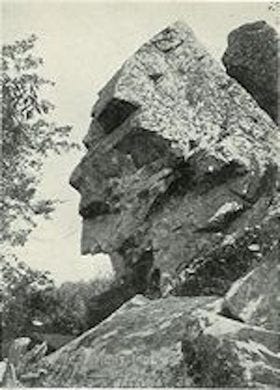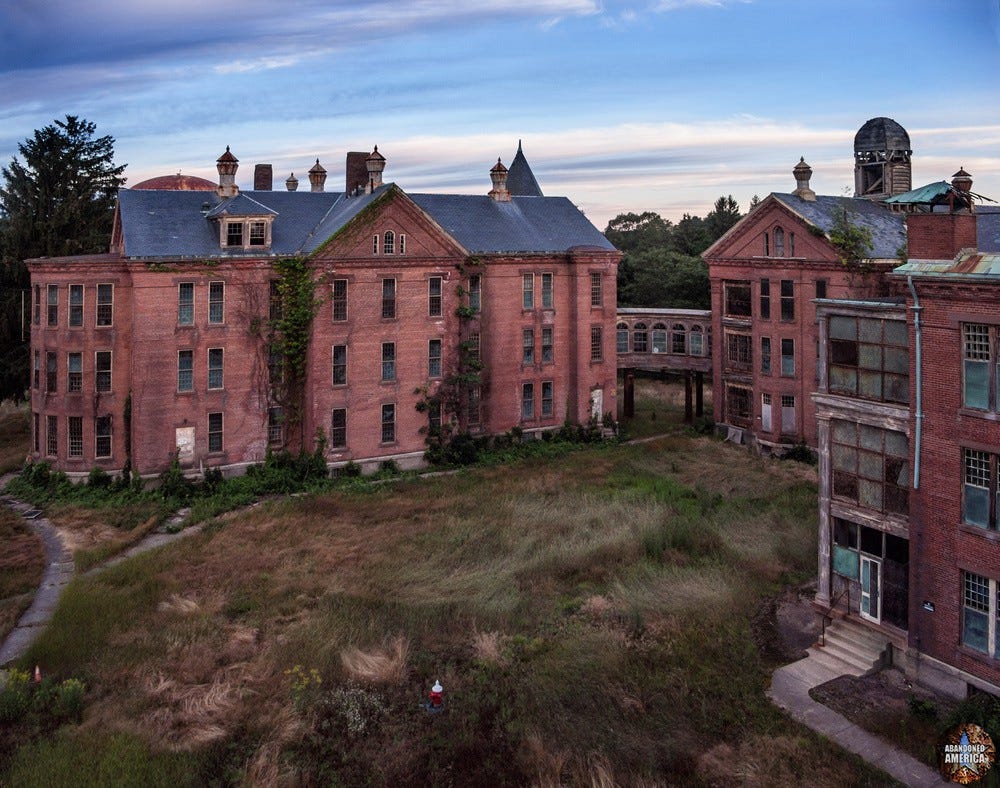Welcome to another edition of The Legend Queens!
Amber and Austin are back with a special off-season episode, adding to the collection of The Haunted Properties series. Amber is flying you all the way to Japan to investigate the Aokigahara Forest and the suicides that have plagued its history. Meanwhile, Austin is staying closer to home in Massachusetts to explore the Bridgewater Triangle, an area notorious for various entities and paranormal phenomena that have seemingly plagued it for centuries.
Happy Pride Month and we hope you consider liking, sharing, commenting, or a helping us out with a paid subscription.
Shall we begin?
Aokigahara Forest
Written by: Amber Brevig
Trigger Warnings: Suicide, senicide, depression, violence

At the base of Mount Fuji sits the gorgeous Aokigahara forest. Brimming with life (and death), this thirteen-and-a-half square mile “Sea of Trees” has served as the final destination for hundreds of its Japanese visitors. But *why* do so many decide to end their own lives in the forest, and do yūrei (roughly translating to “dim spirit” in English… a.k.a. *ghosts*) walk the mossy grounds?
Let’s Give Some Context
But first, a quick disclaimer- I think it’s important to remember that we’re talking about *real people* while we’re talking about ghosts and tales of suicide - these were human beings with families (who may be still alive and mourning) and lives outside of the forest. Please note nothing said in this writing is meant to be disrespectful or disregard the lives lost and how serious depression and suicidal thoughts can be. If you’re having suicidal thoughts, get some help. Seriously - Talk to someone.
While the Western world and Christian nations tend to view suicide as selfish or immoral, Japan has pockets in its history where dying by your own hand was seen as a noble act. The Morbid Curiosity Podcast does a great job of discussing how society upheld seppuku (when samurai would cut their stomachs rather than be killed by their enemies // as a punishment for crime or deep shame) and the kamikazes (bomber pilots) as honorable.
Since World War II, various authors have written about committing suicide specifically in Aokigahara Forest including Tower of Waves, by Seichō Matsumoto and The Complete Manual of Suicide by Wataru Tsurumi, who names the forest “the perfect place to die.” Japan also has a culture of overworking literally to death (they even have a word for it: karoshi) and has a negative stigma surrounding mental health issues (also covered in The Morbid Curiosity podcast episode).
This site is rumored to have been associated with ubasute - the practice of taking elderly members of the community out to remote areas and leaving them out there to die.
All of these things combined serve, to me at least, as a cultural foundation of why so many (estimates of over 100 people per year) take their last breath in the Sea of Trees.
Remains and Rituals
What happens to these human remains after the act is completed? Vice put out a short documentary (below) a few years ago that followed a “forest guardian” - someone who walks the forest trails and follows any tape or other markers that may symbolize a person has gone off trail. If the workers find a body, the remains must undergo an end-of-life ceremony so that the spirit can move on. If the last rites aren’t properly performed, or if the person died too violently, the spirit is believed to remain trapped between the physical and ethereal worlds as a yūrei.
Unfortunately, due to just how large the forest is, there are often bodies that go unfound for *years* before someone happens to stumble across them. So what of their spirits?
Haunted Encounters
Now we’re getting into the meat and potatoes of what I really wanted to dive into in this chapter - what have people experienced in this forest that makes them believe it is haunted? Local folk tales tell children to stay away from the forest because it is evil, but what are the spirits actually *doing* to visitors to get such a heinous reputation?
For my “research” I turned to…. good ol’ Youtube vlogs. Name a better source for first-hand accounts - I dare you.
And what did I find??!
The same thing we find with basically every haunted property we’ve covered (and if you haven’t read Season 2 of The Legend Queens, this might be a slight spoiler) - paranormal investigators can pull out all of the equipment they want, but they have yet to capture the image of a yūrei.
Although images are fleeting, investigators seem to have no problem getting REM pods and spirit boxes to light up with activity. Despite the majority of the dead being Japanese, somehow these spirit box sessions always produce answers in English.
Take the following video of Kelsi Davies for example (and I swear I watched ten videos from various paranormal teams that were all similar) - Davies and her partner enter the forest in the dark of night (starting at 42:02). While there, the two follow close to a worn trail, even passing by an old building and a vehicle that’s covered with a tarp in the footpath. They consistently hear twigs snapping all around them, and the second they turn on their equipment, they get a *ton* of audible feedback - hearing things like “leave now” and “strangled” come through clearly. The pair seems to leave the forest after a few short hours and after maybe traveling a few football fields deep into the trees.
Walking away from the spectral shadows and whispering trees of Aokigahara, we are left with more questions than answers. The forest, with its rich tapestry of life, death, and the supernatural, invites us to reflect on the cultural and personal reasons behind the tragedies it conceals. The ghost stories, while intriguing, should not overshadow the real and pressing issue of mental health awareness. Aokigahara stands as a poignant symbol of the silent battles many face daily. Let the stories of yūrei remind us of the living, urging us to foster a more compassionate world where those in despair feel seen, heard, and supported.
The Bridgewater Triangle
By: Austin Charles Bolkcom
Stretching for about 200 square miles in southeastern Massachusetts is a stretch of land dubbed the Bridgewater Triangle. It is apparently home to several paranormal phenomena, including UFO activity, poltergeists and other ghost-like activity, several sightings of Bigfoot-type creatures, giant snakes, and even thunderbirds.
The Triangle is host to many such activities, but the most notable locations within the Triangle are Freetown-Fall River State Forest, Profile Rock, Solitude Stone, Bridgewater State University, Taunton State Hospital, and Hornbine School. Each of these locations has its own unique type of activity and noteworthy history that I’ll dive into for this edition.
Renowned cryptozoologist Loren Coleman was the first person to coin the term "Bridgewater Triangle" in the 1970s. As a paranormal researcher, Coleman has been intrigued by the area's paranormal accounts and has traced paranormal activity back to the 1760s.
Profile Rock

In Massachusetts, the silhouette of what has come to be known as Profile Rock resembles the craggy visage of a man's face. Though at one time, it was thought to be that of the Wampanoag Chief Massasoit Sachem. The face in the rock had not always been there and appears to have come into existence sometime in the mid-1800s, likely due to dynamite. Nonetheless, the face became revered among the local tribes, who believed it depicted the great leader Sachem, the father of Philip of King Philip’s War.
History does not tell us when Massasoit became connected to or associated with Profile Rock, but it is known that the mountain was considered sacred long before Massasoit came into power or even his birth. For generations, the Wampanoag people gathered there to discuss tribal issues and used the mountain formation to protect themselves against their enemies. It was a vital part of their culture, being easily accessible and high enough to provide a view of much of the surrounding land, giving them an advantage when scouting and hunting.
No matter what you call it, whom it might resemble, or when you agree it was formed, one thing that can be agreed upon is that the rock has garnered an air of the supernatural, with local legends of ghosts, satanic cults, and murder surrounding the site. Ghost lights have been reported by numerous visitors and hikers while some even noting that they can hear the faint beat of a war drum rumbling in the forest when near the rock.
Unfortunately, due to weather-related events, as of 2019, large chunks of the rock have fallen or broken off, which has taken away the allure and appearance the rock once had. It no longer resembles a face but is now just a heap of large rocks.
Taunton State Hospital

It wouldn’t be a haunted location without a hospital being involved. Taunton State Hospital, home to the mentally unwell and criminally insane, fits the typical stereotype of a location haunted by past residents due to the mass amount of negative activity and horrible treatment of the patients that occurred onsite during its most active operation. Hospitals see birth, death, illness, and healing. They see families as exuberant or mourning. They witness brilliant energy or dark shadows and pain.
Facing mass pressure to open another facility for the mentally unwell, Massachusetts opened up Taunton to deal with patient overflow happening at their Worcester location. The hospital, first established in 1854 and originally known as the State Lunatic Hospital at Taunton, has since become synonymous with eerie tales and ghostly encounters. Taunton State bore witness to hundreds of psychiatric patients and, more notably, a couple of notorious serial killers. Innocent people such as veterans who sustained brain injuries and those with Alzheimer’s, Parkinson’s, and Tourette’s Syndrome were admitted to the hospital. Women who experienced anxiety and panic attacks, post-partum depression, and even fatigue were also high on the list of those brought to the hospital.
During its active years housing patients, it was a wide known rumor in the hospital and surrounding town that the hospital itself was possibly operated by members of a satanic cult. According to these rumors, patients were used by cult members to perform dark rituals and even sacrifices. Today there are still many accounts of blood curdling screams coming from disembodied ghosts that are still haunting the grounds.
The main portion of Taunton State Hospital was closed in 1975 due to the mass decay and destruction that had gone on without any renovations or updates to keep it in shape to serve their patients. However, several parts of the hospital today are still standing and being used by the state of Massachusetts.
Freetown-Fall River State Forest

Behind its beautiful shady paths and sunny clearings, the Freetown State Forest conceals a dark and troubling reputation. For years, it has been a hotspot for terrifying real-life incidents and rumored supernatural happenings. The history of this mysterious Massachusetts location is steeped in murder, fear, and the paranormal, earning it the nickname "The Cursed Forest of Massachusetts." This reputation is not based on rumors alone. The forest was the site of several murders in the late 1900s, and the town was rumored to harbor a satanic cult that performed rituals and sacrifices in the woods. Many locals reported to authorities that they believed this cult was responsible for the bizarre murders in the area.
Suspicious clearings, stained with animal blood, were found in the Freetown Forest. The curiously arranged carcasses of cattle were later discovered in the woods, lending more steam to the rumors of ritual sacrifice within the forest.
—Sophia, writer
The forest is rumored to be home to a race of humanoid creatures known as Pukwedgies, long recognized by the native Wampanoag tribe. These troll-like beings are described as being between 2 and 3 feet tall, with smooth, hairy grey skin that is said to glow occasionally. Pukwedgies have a reputation for mischief and mayhem, often startling people, throwing rocks or sand in their faces, pushing or shoving them, kidnapping them, hurling them from cliffs, wrestling with them, or even attacking them with knives or spears. According to legend, Pukwedgies are skilled magic users and shapeshifters. The natives avoid these creatures, claiming they cannot be trifled with or approached. Numerous visitors to the forest have reported sightings of these beings, who are blamed for the high number of people supposedly falling to their deaths from cliffs in the area.
Back in 1974, then-governor Ronald Reagan reported seeing strange lights in the sky within the Freetown State Forest. Reagan was flying in a Cessna over The Ledge, a rock quarry in the forest, accompanied by pilot Air Force Colonel Bill Paynter and two security personnel. They noticed strange lights tailing the plane, which accelerated, decelerated, and elongated within minutes. The lights then reportedly shot upwards at a 45-degree angle and disappeared. Reagan recounted the incident to Norman C. Miller, the Washington bureau chief for the Wall Street Journal, later that year.
No matter where you find yourself in the Bridgewater Triangle, you are bound to encounter some case of the paranormal and otherworldly if you pay close enough attention. This stretch of land seems to be plagued with varying levels of activity that would satisfy any paranormal investigative junkie.









